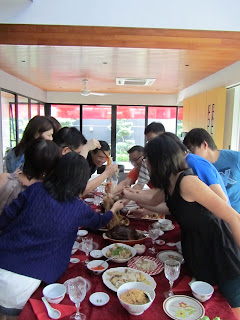The
last time we went to Kinabalu Park was 7 years ago, when SK was still young. I remember it was rainy season and the ground was wet and soggy.
Now that SK is older and has developed an interest in plants, we decided to make a trip to look for the largest pitcher plants in the world - the Nepenthes Rajah. The wet season should have been over by now but still there were a couple of rainy days during our trip.
Thank goodness the weather was perfect when we arrived at Kinabalu Park entrance after a 2-hour drive from the city.

At 1,500m above sea level, the air was chilly and misty. This is the starting point of the trek for most visitors. We had done this before, so we opted for the Mesilau trail which is rich in plants and wildlife.



We hopped into the coach for a drive up to the Mesilau Gate at 2,000m above sea level.

This trail was opened to the public in Oct 1998 initially for scientists and researchers. We had to register and pay a fee at the Mesilau Gate. Besides, we had to engage a guide who specialises in plants to bring us in.
Indeed, there are lots of fascinating plants and trees covered in spongy mosses and liverworts along the trail.

Some of the common plants here include the wild peony and begonia.
We crossed a hanging bridge which overlooks the Mesilau River.


The terrain on the other side is completely different. From here, the trail follows the ridge, rising steeply, up and up in a series of steps.

That was when we saw the first pitcher but not that of the Nepenthes Rajah.

Then we stumbled upon the Rajah!

And our guide spotted even larger pitchers.

So large that my head could almost fit into a pitcher. The largest pitchers can hold up to 3.5 litres of water!

The fine weather was threatened by a thick cloud moving in our direction. We had to descend quickly before the swirling clouds obstruct our visibility.

Going downhill is always more challenging. One slip will send you tumbling down into the gorge below.

SK was still shooting away on the way down.

The attraction of the orchids and wild flowers was too strong to resist.




We managed to leave Mesilau before the rain came. By the time we got down to the Kinabalu Park entrance, the buildings were shrouded in mist.

We took a short tour around the Botanic Garden and left Kinabalu Park with fond memories.

On the way back, we stopped by some roadside fruit and vegetable stalls.

Some of the local fruits in season include rambutan, langsat, mangosteen and chiku.
We tried the strange looking fruit called Talap and an unusual looking 'mata kuching' with scaly skin.


I spotted the edible fern and wished I could buy some home.

Most of the local farmers grow cabbage, cauliflower and bak choy.

They're famous for the local honey too.

Everything grows better in the cool environment. Just look at the size of the amaryllis flowers!
































































